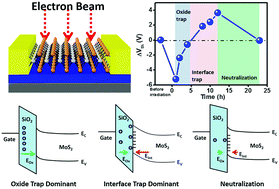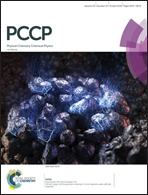Time-evolution of the electrical characteristics of MoS2 field-effect transistors after electron beam irradiation†
Abstract
As the feature sizes of devices decrease to the nanoscale, electron microscopy and lithography will become increasingly essential techniques for fabrication and inspection. In this study, we probed the memory effects of MoS2 field-effect transistors (FETs) subjected to electron beam (e-beam) irradiation; after fabricating the devices on 300 nm SiO2/Si substrates, we irradiated the MoS2 FETs with various doses of irradiation from a 30 kV e-beam. The threshold voltage shifted to the negative side and the mobility increased—a so-called memory effect—upon increasing the e-beam dose. These changes resulted from positively charged oxide traps, formed upon e-beam irradiation, in the gate oxide layer. Interestingly, the electrical characteristics of the MoS2 FETs after e-beam irradiation continued to change upon aging: the threshold voltage shifted toward the positive side and the mobility decreased, suggesting that the dominant mechanism changed from the presence of positively charged oxide traps to the presence of negatively charged interface traps. Notably, the threshold voltage shifts of the MoS2 FETs could be retained for one or two days. This behavior should be useful for preparing property-adjustable nanodevices, with particular potential for applications in multi-level memory devices.



 Please wait while we load your content...
Please wait while we load your content...